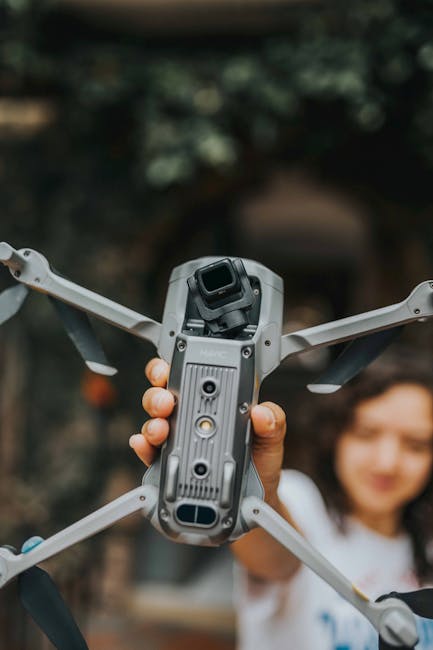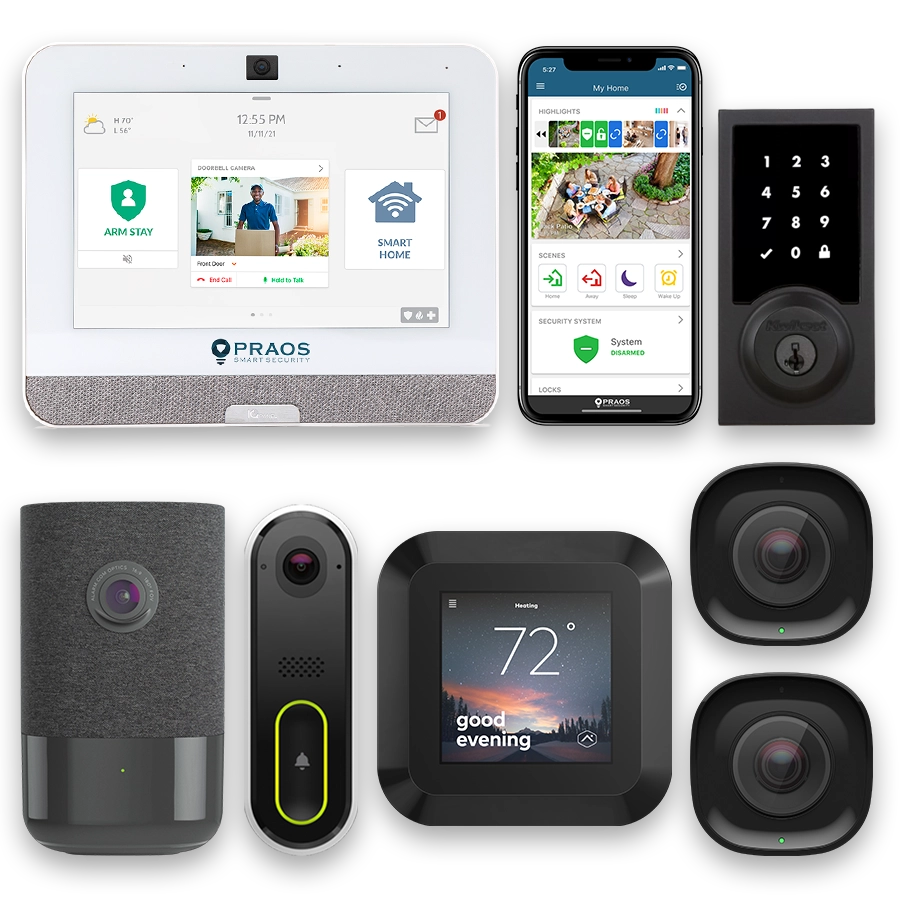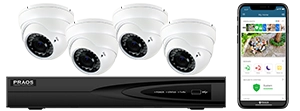- Introduction to Small Business Security Needs in Richmond
- Current Security Challenges Faced by Small Businesses
- Advantages of Integrating Wireless Cameras and Access Control Systems
- Selecting the Right Wireless Camera Solutions
- Choosing Appropriate Access Control Systems
- Case Studies of Successful Security Implementations in Richmond
- Best Practices for Installing and Maintaining Security Systems
- Future Trends in Small Business Security Technology
Introduction to Small Business Security Needs in Richmond
Keeping small businesses secure is a fundamental need, particularly in Richmond, where the landscape of small enterprises is diverse and vibrant. Effective security solutions not only safeguard assets but also ensure the safety of employees and customers. Understanding the unique needs of small businesses in Richmond are the first step in designing comprehensive security solutions.
Small businesses in Richmond, much like those in other urban areas, contend with a variety of security challenges. These businesses often have limited budgets and resources, making it crucial to find cost-effective and scalable security solutions. Additionally, these enterprises typically face higher risks related to property crimes, such as theft and vandalism, due to their size and sometimes limited security measures.
The need for robust security solutions is reflected in crime statistics for Richmond. According to the FBI’s Uniform Crime Reporting (UCR) Program, property crimes accounted for a significant portion of reported incidents in the area. As of the latest data:
| Year | Number of Property Crimes in Richmond |
|---|---|
| 2021 | 15,232 |
| 2020 | 16,197 |
The above statistics underscore the importance of having a security plan in place. For small businesses, an effective security plan includes both preventative and responsive measures. The goal is not only to deter criminal activities but also to quickly respond to and manage any incidents that occur.
A holistic approach to security for small businesses in Richmond involves multiple layers of protection. The most vital components include:
- Surveillance: Utilizing wireless cameras to monitor premises in real-time.
- Access Control: Implementing systems to manage and restrict entry to critical areas.
The integration of these components forms the backbone of a comprehensive security system. Wireless cameras can help monitor various areas of the business continuously, while access control systems can prevent unauthorized access and provide detailed logs of entry and exit activities.
To sum up, addressing the security needs of small businesses in Richmond require an understanding of the unique challenges these enterprises face. By integrating technologies such as wireless cameras and access control systems, businesses can create a secure environment that not only protects assets but also ensures the safety of their patrons and staff. This integrated approach is essential for creating a resilient, secure small business community in Richmond.
Current Security Challenges Faced by Small Businesses
Small businesses in Richmond face a variety of security challenges that can impact both their operations and their bottom line. Understanding these challenges is crucial for creating effective security solutions. The most common issues include theft, vandalism, unauthorized access, and internal security breaches. Additionally, small businesses often have limited budgets, making it difficult to implement comprehensive security measures.
Theft and Vandalism
Theft and vandalism are significant concerns for small businesses. According to the 2019 National Retail Security Survey, retail shrinkage—mainly caused by external theft—cost U.S. retailers $61.7 billion. While these figures primarily reflect larger markets, the impact on small businesses can be even more devastating due to their limited financial resources. Vandalism, such as graffiti or property damage, also poses a consistent threat, often requiring costly repairs and leading to business interruptions.
Unauthorized Access
Unauthorized access is another major concern for small businesses. Access control is important to mitigate risks such as break-ins or unauthorized entries, which can lead to theft of assets, sensitive data breaches, or even physical harm to employees. A robust access control system helps ensure that only authorized personnel can enter certain areas of the business premises.
Internal Security Breaches
Internal security breaches present an often-overlooked risk. Employees may accidentally or maliciously compromise security, whether through theft, data breaches, or other forms of misconduct. According to a report by the U.S. Chamber of Commerce, employee theft accounts for approximately 75% of inventory shortages and costs U.S. businesses up to $50 billion annually. Having security measures like surveillance cameras and access controls in place can help deter such activities and identify issues swiftly when they occur.
Budget Constraints
Budget constraints significantly affect the ability of small businesses to implement comprehensive security solutions. Many small businesses operate on thin margins, making it challenging to invest in high-end security systems. However, the cost of addressing security incidents, whether through direct financial losses or long-term impacts, often justifies the investment in robust security measures.
The challenges outlined above necessitate an integrated approach to security. By combining wireless cameras and access control systems, small businesses in Richmond can enhance their security posture, deter criminal activities, and create a safer environment for employees and customers.
Advantages of Integrating Wireless Cameras and Access Control Systems
Integrating wireless cameras and access control systems offers several advantages for small businesses in Richmond. These technologies can significantly enhance security measures, ensuring that businesses are better protected against various threats and can operate more effectively.
One major advantage is the flexibility and scalability of wireless camera systems. Unlike traditional wired systems, wireless cameras can be easily deployed and repositioned as needed. This allows businesses to adapt their security setup to changing requirements without significant investment in overhauling their existing infrastructure.
Wireless cameras also provide remote monitoring capabilities. Business owners and security personnel can access live feeds from their cameras via the internet, using smartphones, tablets, or computers. This feature ensures that the premises can be continuously monitored, even when personnel are off-site. Such accessibility is crucial for promptly responding to incidents and maintaining overall security.
When combined with access control systems, wireless cameras can further enhance security by providing a robust means of controlling and monitoring entry into business premises. Access control systems use methods such as key cards, biometric scanners, or mobile credentials to grant or restrict access to secured areas. By creating an audit trail of entry and exit logs, these systems help in maintaining transparency and accountability.
Integrating access control with wireless cameras can create a more comprehensive security approach. For example, if an access control system registers an unauthorized access attempt, the nearby camera can be programmed to capture footage of the incident, providing valuable visual evidence for security personnel to review. This synchronization can aid in quicker threat detection and resolution.
Moreover, integration can enhance operational efficiency. Security systems that operate independently might require constant manual supervision and intervention. However, a unified system where wireless cameras and access control are integrated can automate several processes. For example, the system can automatically lock down certain areas if a security breach is detected, reducing the need for human intervention.
Another advantage of integrating these systems is cost-effectiveness. Implementing a cohesive solution that combines wireless cameras and access control systems can be more economical than deploying separate, standalone security systems. Over time, the operational efficiencies and improvements in security can contribute to a better return on investment.
In conclusion, integrating wireless cameras and access control systems offers small businesses in Richmond a multifaceted security solution. The flexibility, remote accessibility, enhanced incident response, improved operational efficiency, and cost-effectiveness of such integrated systems provide a compelling case for their adoption in safeguarding assets and ensuring the safety of the premises.
Selecting the Right Wireless Camera Solutions
When selecting the right wireless camera solutions for small businesses in Richmond, it is crucial to evaluate the specific needs of the business, as well as the unique characteristics of the premises. Wireless cameras offer flexibility and scalability, making them an ideal choice for small businesses. However, the selection process involves several key considerations.
Image Quality and Resolution
One of the primary factors to consider is the image quality and resolution of the cameras. High-definition (HD) cameras, with resolutions of 720p or 1080p, are commonly recommended as they provide clear and detailed video footage. Some businesses may require even higher resolution cameras, such as 4K, to capture finer details.
Field of View
The field of view (FOV) of the camera determines the area that the camera can cover. Wide-angle lenses are beneficial for monitoring large areas with a single camera, while more focused lenses are suitable for specific spots. It is essential to balance the FOV with the resolution to ensure optimal coverage without sacrificing image quality.
Low Light and Night Vision Capability
Security cameras need to perform well in various lighting conditions, especially at night. Cameras with infrared (IR) night vision or low-light sensors are crucial for capturing clear images in poorly lit environments. The specified night vision range should match or exceed the distance of the areas needing surveillance.
Weather Resistance
For outdoor installations, it is important to choose cameras that are weather-resistant. Cameras rated with IP65 or higher are typically well-suited for exterior use, providing protection against dust and water. This ensures durability and reliable performance in all weather conditions.
Wireless Connectivity and Range
Given the wireless nature of these cameras, their connectivity and range are significant considerations. Ensure compatibility with the existing network infrastructure and check for robust wireless signal strength to avoid blind spots. Cameras supporting dual-band Wi-Fi (2.4 GHz and 5 GHz) often provide better connectivity options.
Storage Options
Consideration of how video footage will be stored is crucial. Options include local storage on SD cards, network-attached storage (NAS), or cloud storage services. Each option has its advantages and trade-offs, including costs and accessibility. Small businesses should choose a storage solution that aligns with their data retention policies and budget.
Scalability
As businesses grow, their security needs may evolve. Therefore, selecting a system that can be easily expanded is beneficial. Ensure that the wireless camera solution supports adding more cameras without requiring significant infrastructure changes.
Integration Capabilities
Finally, the ability of the wireless camera system to integrate with other security solutions, such as access control systems and alarm systems, can provide a more comprehensive security setup. Look for solutions that offer APIs or compatibility with popular security platforms.
By carefully considering these factors, small businesses in Richmond can select wireless camera solutions that not only meet their current security needs but also provide room for future growth and enhancements.
Choosing Appropriate Access Control Systems
When it comes to choosing appropriate access control systems for small businesses in Richmond, a range of factors must be considered to ensure the system effectively meets security needs. Access control systems vary widely in functionality, complexity, and cost, making it crucial to select a solution that aligns with business requirements and budget constraints.
Types of Access Control Systems
Access control systems can be broadly categorized into three main types, each offering different levels of security and features:
- Discretionary Access Control (DAC): This system allows the business owner to decide who can access specific areas. It’s flexible but can be less secure since user permissions can become decentralized.
- Mandatory Access Control (MAC): This highly restrictive model ensures that access permissions are controlled by a central authority, commonly used in organizations requiring high security.
- Role-Based Access Control (RBAC): Permissions are assigned based on roles within the business. This is beneficial for organizations that need to streamline access permissions based on job functions.
Features to Consider
Key features to look for when choosing access control systems include:
- Authentication Methods: Multifactor authentication (MFA) is recommended to enhance security. Options include key cards, biometric scanners, and mobile access credentials.
- Integration Capabilities: The system should integrate smoothly with existing security measures like wireless cameras, alarm systems, and property management software.
- Scalability: Ensure the system can grow with your business, supporting additional users and access points without excessive costs.
- User Management: The system should provide straightforward user management, offering functionalities such as adding, removing, or modifying user permissions easily.
Comparison of Popular Access Control Systems
Below is a comparison of some popular access control systems suitable for small businesses:
| System | Key Features |
|---|---|
| Brivo | Cloud-based management, mobile credentials, integrated video surveillance |
| HID Global | Multifactor authentication, integrated with various security products, customizable access policies |
| Honeywell | Role-based access control, video integration, scalable solutions |
| Kisi | Mobile access, real-time access logs, tailgating detection |
Each of these systems offers unique benefits and selecting the right one will depend on the specific needs and constraints of the business. It’s recommended to conduct a thorough assessment or consult with a security expert to identify the best match.
Case Studies of Successful Security Implementations in Richmond
Several small businesses in Richmond have successfully implemented comprehensive security solutions that integrate wireless cameras and access control systems. These case studies highlight practical approaches and the benefits achieved.
Example 1: Local Retail Store
A local retail store aimed to deter theft and monitor employee activity. They installed a network of wireless cameras covering key areas such as entrances, exits, and the sales floor. The system provides live feeds accessible via mobile devices, enhancing the owner’s ability to monitor activity remotely.
The store integrated an access control system at its main entry points, allowing only authorized employees to enter restricted areas such as stockrooms. This reduced unauthorized access and inventory loss. Overall, the implementation of these security measures resulted in a noticeable decrease in theft and improved staff accountability.
Example 2: Office Building
An office building in Richmond, housing multiple small businesses, adopted a comprehensive security system to ensure tenant safety and safeguard assets. The building management installed wireless cameras in common areas, entrances, and hallways, providing continuous surveillance and recording capabilities.
Access control systems with keycard entry were employed at all main doors, restricting access to authorized personnel only. The system also enabled individual businesses within the building to control access to their specific offices. Tenants reported an increased sense of security and reduced incidents of unauthorized access.
Example 3: Restaurant
A Richmond-based restaurant faced issues with vandalism and after-hours break-ins. They installed wireless cameras at all entry points, dining areas, and around the outside perimeter. The camera system’s night vision and motion detection features significantly enhanced after-hours security.
To reinforce security, the restaurant implemented an access control system allowing only staff to enter through the back entrance and restricted areas like the kitchen and storage rooms. This dual approach of surveillance and controlled access improved overall security and contributed to a safer work environment.
These real-world cases underscore the effectiveness of integrating wireless cameras and access control systems to address common security challenges in Richmond’s small businesses. The implementations showcase how combining these technologies can result in tangible improvements in security, operational efficiency, and peace of mind for business owners and employees alike.
Best Practices for Installing and Maintaining Security Systems
Installing and maintaining security systems effectively requires adherence to a set of best practices to ensure optimal performance and reliability. The following guidelines provide a comprehensive approach to implementing and maintaining wireless cameras and access control systems in small businesses.
Pre-Installation Planning:
- Assessment: Begin with a thorough assessment of the property to identify vulnerable areas and determine the necessary coverage. This can include entrance points, high-traffic areas, and valuable asset locations.
- Design: Create a detailed layout that specifies the placement of cameras and access control points. This design should consider factors such as camera range, lighting conditions, and the potential for obstructions.
- Compliance: Ensure that the design complies with local regulations and industry standards, particularly regarding privacy laws and data protection requirements.
Installation Best Practices:
- Professional Installation: Whenever possible, enlist the services of certified security professionals. Their expertise can prevent common installation errors and ensure that the system is set up correctly.
- Power Supply and Connectivity: Verify that all cameras and access control systems have a reliable power supply and stable network connectivity. Utilize power-over-ethernet (PoE) where appropriate to simplify wiring and reduce installation costs.
- Calibration: After installation, calibrate cameras and access control devices to ensure optimal performance. This includes adjusting camera angles, setting up motion detection zones, and configuring access permissions.
Regular Maintenance:
- Routine Inspections: Schedule regular inspections to check for any wear and tear, damage, or malfunctions. This includes cleaning camera lenses, checking for firmware updates, and ensuring access control systems function correctly.
- Testing: Periodically test the entire system to ensure it operates as intended. This involves checking camera feeds for clarity, verifying that motion detection and alert systems work, and confirming that access controls grant and restrict access appropriately.
- Documentation: Maintain detailed records of the security system, including installation documents, user manuals, and maintenance logs. This documentation is invaluable for troubleshooting and future upgrades.
Employee Training:
- Initial Training: Provide comprehensive training for all employees on how to use the security systems. This includes showing them how to access camera feeds, report issues, and understand access control procedures.
- Regular Updates: Offer periodic training sessions to refresh employees’ knowledge and update them on any changes or upgrades to the system. This helps maintain a high level of security awareness within the organization.
By following these best practices, small businesses in Richmond can ensure their security systems are effectively installed and maintained, providing robust protection against potential threats.
Future Trends in Small Business Security Technology
When it comes to the future of small business security technology, there are several emerging trends that are poised to revolutionize the industry. Innovations in wireless cameras and access control systems, coupled with advancements in smart home technology, are paving the way for more integrated and intuitive security solutions. Companies like Praos are at the forefront of these developments, ensuring that businesses have access to the latest technologies to keep their properties safe.
One of the most significant trends is the shift towards interconnected security ecosystems. The notion of a standalone security system is becoming obsolete, as more businesses are opting for integrated solutions that offer a unified platform for surveillance, access control, and automation. Solutions offered by Praos, for instance, exemplify this trend with their connected app that integrates security, automation, and surveillance systems. This allows business owners to monitor and manage their security effortlessly from a single point of control.
Additionally, advancements in artificial intelligence (AI) and machine learning are playing a crucial role in enhancing the capabilities of security systems. Modern wireless cameras are becoming smarter, equipped with features such as facial recognition, anomaly detection, and behavioral analytics. These capabilities enable more proactive security measures, where potential threats can be identified and addressed in real-time. Praos leverages these advanced technologies to offer systems that not only secure but also understand the environment they are monitoring.
Cloud-based solutions are also becoming more prevalent, providing businesses with enhanced flexibility and scalability. By utilizing cloud storage, small businesses can ensure that their surveillance data is securely stored and easily accessible. This reduces the risk of data loss associated with on-site storage solutions and allows for remote monitoring from any location. Praos offers solutions that integrate cloud-based storage, ensuring that critical data is preserved and accessible whenever needed.
Moreover, the trend toward mobile-centric security management is gaining momentum. Business owners are increasingly relying on smartphones and other mobile devices to manage their security systems. The app developed by Praos encapsulates this trend, offering a user-friendly interface that provides complete control over surveillance cameras, locks, and other automated systems. This makes it convenient for small business owners to stay connected to their premises, regardless of their physical location.
Another emerging technology is the Internet of Things (IoT), which interconnects various devices and systems to enhance functionality and provide a cohesive security solution. Through IoT, security systems can integrate with other business operations, offering features like energy management, climate control, and more. As IoT continues to evolve, small businesses can expect more seamless and comprehensive security solutions. Praos’s approach to a connected home experience is an indication of where the industry is heading, offering integrated solutions that transcend traditional security functionalities.
Finally, enhanced data analytics is becoming a crucial component of modern security systems. Businesses can leverage this data to gain insights into security vulnerabilities, operational efficiency, and more. The ability to analyze data in real-time and make informed decisions is transforming how security is managed. Future systems from providers like Praos will likely incorporate these analytics tools, offering businesses actionable insights to better protect their assets.
In conclusion, the future of small business security technology is geared towards creating smarter, more integrated systems that not only protect but also add value to business operations. With companies like Praos leading the charge, businesses in Richmond can look forward to adopting innovative solutions that ensure safety and enhance operational efficiency.






